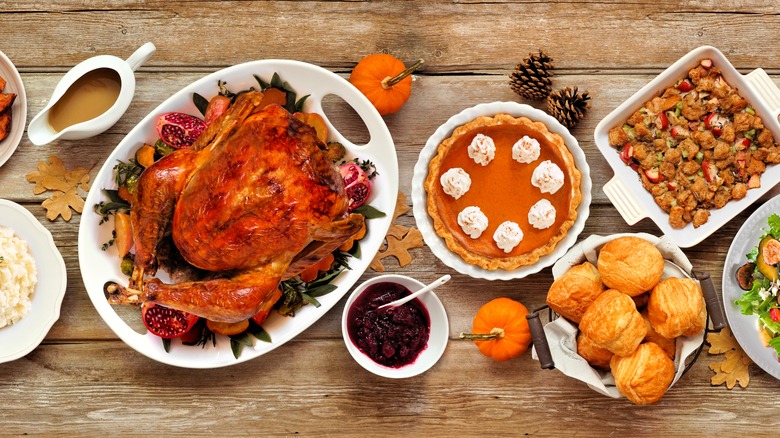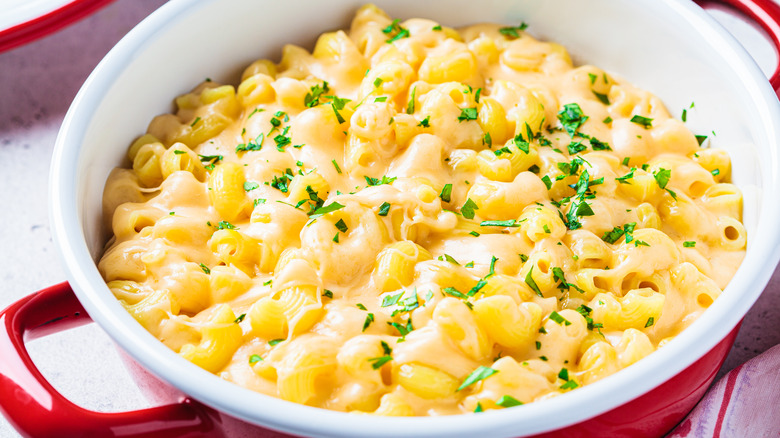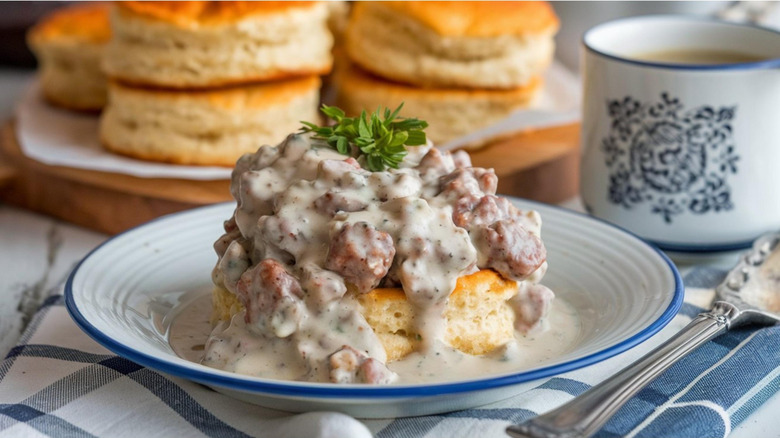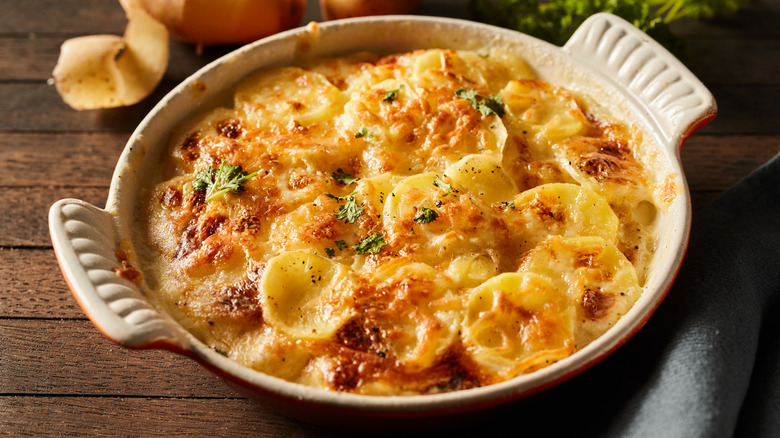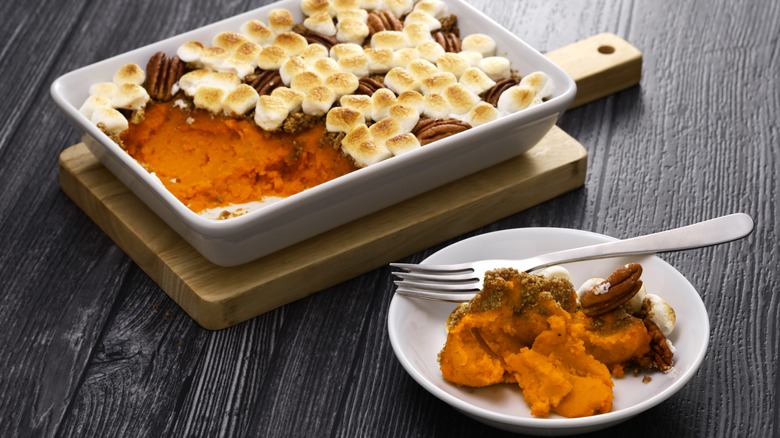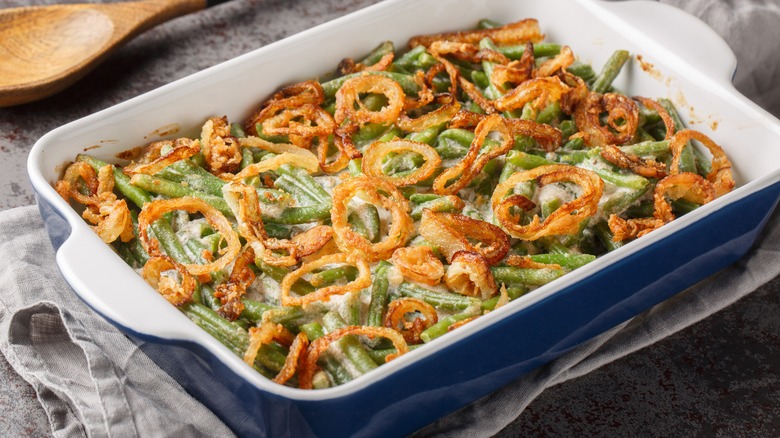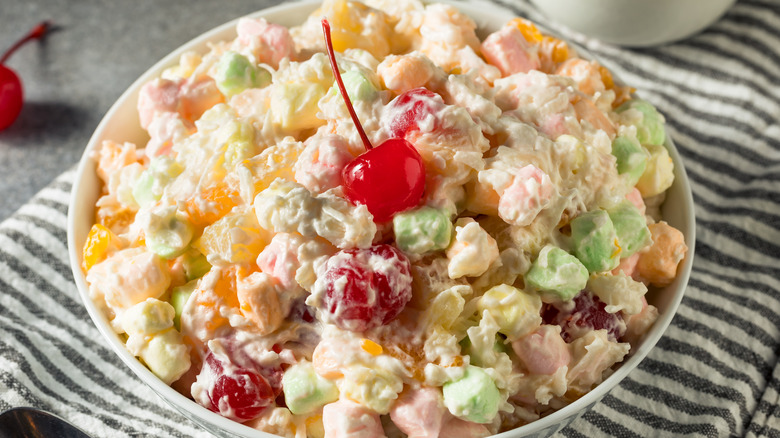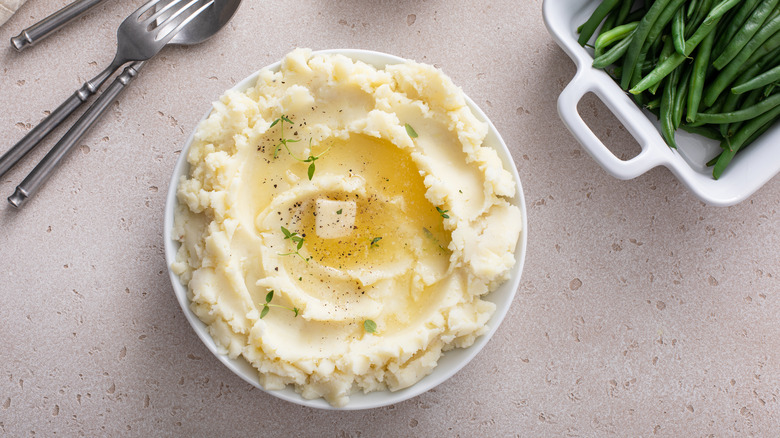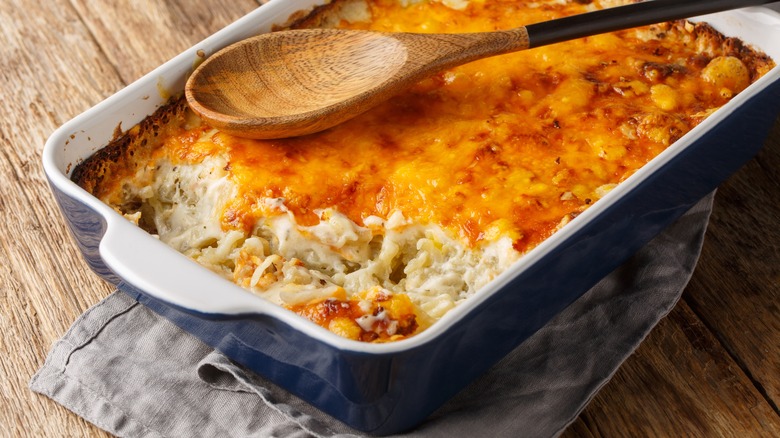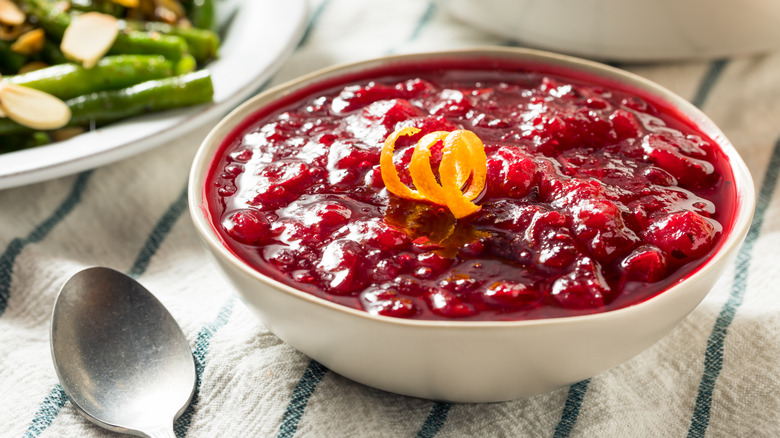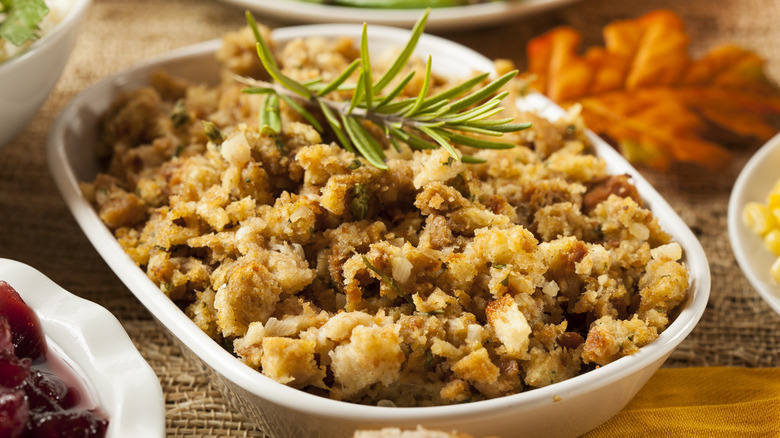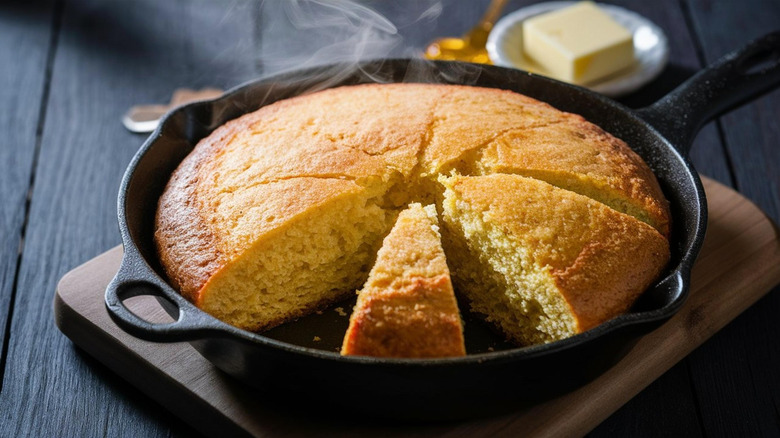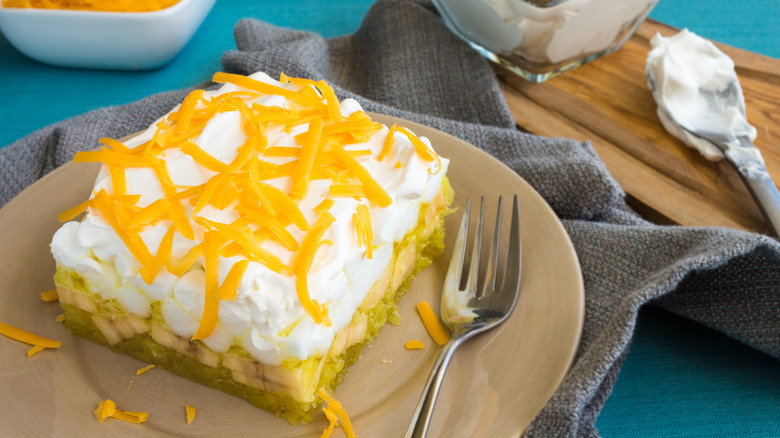Unhealthy Thanksgiving Sides You Should Consider Avoiding
Thanksgiving is all about getting together with friends, expressing gratitude for the year gone by, and, of course, eating. This cozy holiday is nothing without the customary Thanksgiving feast. Thanksgiving is a great opportunity to lay on an unforgettable spread for friends and family, from the traditional turkey centerpiece to the fall-themed desserts.
Thanksgiving is meant to be a time to let go and have fun, but it's all too easy to overindulge. Despite being the supporting characters, many well-loved holiday sides are deceptively calorific and loaded with salt, sugar, and saturated fat.
Along with other hosting pitfalls, like burning the potatoes or undercooking the bird – one of the most common mistakes people make with Thanksgiving turkey — laying on too many side dishes can make your table a minefield for health-conscious diners. If you want to enjoy a healthier Thanksgiving this year, consider avoiding these well-known side dishes or using recipe tweaks to get the calorie count under control.
Mac and cheese is crammed with fat
It's hard to find a more calorific (or delicious) combo than creamy cheese sauce and soft, perfectly cooked noodles. However, a scoop of mac and cheese can drastically increase the calories on your Thanksgiving plate. Most homemade mac and cheese recipes start with a roux of whole milk and butter bulked out with grated cheddar, cream cheese, and even heavy cream to make it extra silky and enticing. Some — read the best — mac and cheese recipes even include bacon bits, which up the ante taste-wise but also increase the fat content.
A 1-cup serving of homemade mac and cheese can clock over 500 calories and around 24 grams of fat, depending on the recipe used and the amount of cheese you add. Many mac and cheese recipes are also high in sodium, while boxed mac and cheese, like Kraft, contains a whopping 561 micrograms of sodium per serving. Boxed mac and cheese is also considered an ultra-processed food and contains some non-natural additives and preservatives. However, it can still be a handy substitute for the real thing if you run out of time on the day. While boxed mac and cheese does expire, it can generally be used after the best-by date and contains 259 calories in a portion.
Biscuits contain heaps of butter
Biscuits are known for having a soft, flaky texture that pairs oh-so-well with roasted turkey and a slather of gravy. Unfortunately, biscuits get that mouthwatering consistency from one vital but highly calorific ingredient — butter. To make biscuits, you need lots and lots of butter. Some recipes call for as much as one cup or 250 grams of unsalted butter and a cup and a half of buttermilk.
The butter is grated or chopped into small pieces and added to the dough cold. When these chunks melt during cooking, the dough forms air pockets, which give biscuits their signature crumbly finish. While extremely delicious, using a cup of butter adds around 117 grams of saturated fat to your biscuit batch. Biscuits are also high in carbs and calories, with a typical recipe containing 200-300 calories per serving.
If you can't imagine your Thanksgiving meal without the biscuits, you can make a slightly lower-fat version by replacing the buttermilk with Greek yogurt. However, you will still need to add butter to give your dough some richness and help it bind together.
Potatoes au gratin are super rich
Made from layers of thinly sliced potato and drenched in cream with a crispy cheese topping, potatoes au gratin are the stuff of Thanksgiving dreams. Unfortunately, they are also the stuff of nutritional nightmares, with many recipes containing around 328 calories and more than 18 grams of fat per 1-cup serving. Of course, home recipes will vary depending on the amount of cream, cheese, and butter added, but no matter how you look at this Thanksgiving staple, it's pretty hard to spin it as a healthy side.
Potatoes au gratin are also high in carbs and contain little to no fiber since the potato skins are usually removed. To make this dish healthier, you can swap out cream for a roux of skimmed milk and cornstarch — one of the best substitutes for heavy cream — or use slightly thickened bouillon as your sauce.
Opting for strong-tasting ingredients like parmesan cheese also means the flavor goes further, meaning you can use less to create a cheesy dish. Parmesan is also very low in lactose, making it a good option for anyone with a dairy intolerance.
Sweet potato casserole is a sugar fest
Sweet potatoes are a super healthy carbohydrate high in health-boosting nutrients like potassium, vitamin A, and antioxidants. However, at Thanksgiving, one sweet-potato-based side dish really cranks up the sugar levels, potentially mitigating some of the benefits. Sweet potato casserole is made from mashed, baked sweet potatoes and topped with a sticky marshmallow crust — not exactly a meal your nutritionist would recommend.
Marshmallows are made from a blend of sugar, gelatin, and corn syrup – you can actually make marshmallow fluff at home with just two ingredients, meaning they're low in nutrition and fiber while still high in carbs. A cup of mini marshmallows has around 29 grams of sugar. Many sweet potato casserole recipes also call for added sugar and use butter to make it creamy, which ups the calorie count. You can still enjoy a sweet potato mash on Thanksgiving by swapping out the marshmallows with chopped pecans to give the dish some crunch and add some healthy fats.
Green bean casserole makes a heathy food unhealthy
Like sweet potatoes, green beans are extremely nutritious and definitely something you should add to your diet. Green beans are high in crucial vitamins, like vitamin C, vitamin A, and vitamin K. They also contain antioxidants and high amounts of protein for a green vegetable, with around 2 grams of protein per cup of beans. However, despite these amazing health benefits, green bean casserole — a popular Thanksgiving side — is often high in calories and sodium.
Traditional green bean casserole is made with condensed cream of mushroom soup, which is high in salt. A serving of Campbell's mushroom soup contains 860 micrograms of sodium — 37% of your daily recommended allowance, and 7 grams of fat. By baking your casserole in the oven, you also risk overcooking the beans — one of the main mistakes everyone makes when preparing green beans. While this won't necessarily affect the nutrient content, you'll get a better texture and sweeter flavor if you quickly blanche the beans first and then reheat them in your casserole.
Try using blanched green beans in a parmesan and fresh mushroom bake rather than a traditional casserole. Or simply serve this snappy veg with a knob of butter and a light sprinkling of salt for a super nutritious side.
Ambrosia salad is high in sugar
Ambrosia salad may taste great because it does an amazing job of combining sugar and fat to make one very unhealthy Thanksgiving side dish. Made with whipped cream, powdered sugar, marshmallows, desiccated coconut, and sweet fruits, like tangerine slices and maraschino cherries, the calories in ambrosia salad can stack up quickly. Meanwhile, the high level of carbs can send your blood sugar on a wild ride.
If you want to make a slightly lower-calorie version that still tastes traditional, you can replace heavy cream with Cool Whip. However, Cool Whip is still ultra-processed and is made from a combination of hydrogenated vegetable oil, high-fructose corn syrup, and some artificial chemical preservatives, meaning it's not a great choice if you prefer to eat mainly whole foods. Although the result will be slightly less sugary, Greek yogurt is a healthy whipped cream alternative and pairs well with sweet fruits.
Creamy mashed potatoes contain added calories
A simple and timeless classic, mashed potatoes are many people's favorite part of a traditional Thanksgiving spread. However, while spuds are a great potassium and vitamin C source, many people rack up the calories when preparing mashed potatoes. While adding butter is vital to get a creamy texture, going overboard can turn mashed potatoes into one of the most calorific sides on the table. Many people up the ante even more by mixing in cream cheese or heavy cream to get a really smooth, rich taste.
While this is undeniably delicious and probably one of the main reasons people love Thanksgiving mash, you may want to offer some lighter potato options for any health-conscious guests. Boiled new potatoes with the skins on is an excellent choice. Simply finish with a small knob of butter and a dash of salt to give them some flavor. You can also make mashed potatoes using 2% or low-fat milk.
Hash brown casserole is high in sodium
Similar to green bean casserole, hash brown casserole uses canned soup that doubles as a creamy sauce. It is a Southern Thanksgiving recipe made by mixing frozen or homemade hash browns with cream of chicken soup, cheese, and butter and then baking it in the oven. You can also sprinkle shredded cheese and onion on top. As you can probably imagine, the final product is an irresistible mix of rich, gooey fried potatoes with a crispy top.
While it's easy to see why this would be a Thanksgiving hit, the combination of high-fat ingredients and starchy carbs makes this dish highly calorific. Hash brown casserole can also be extremely high in salt, as the cream of chicken soup often contains a lot of sodium. Canned chicken soup is also fairly high in cholesterol – Campbell's chicken soup lists around 5% of your daily recommended allowance on its nutrition chart — and in saturated fat at 10% of your daily value.
Frozen hash browns are also high in calories, with one store-bought patty containing around 130 calories. Even if you cook them yourself from scratch, hash browns still need to be fried in large amounts of oil to coat the potato throughout and achieve a crunchy, golden finish.
Canned cranberry sauce can play havoc your blood sugar
Thanksgiving dinner just wouldn't feel the same without the cranberry sauce. Because cranberries have a naturally sharp flavor, canned cranberry sauce usually contains a lot of added sugar to mask this bitter taste. A can of Ocean Spray jellied cranberry sauce contains around 23 grams of sugar and 28 grams of total carbs per serving. If you're watching your blood sugar levels, this means that canned cranberry sauce could be a no-go.
While an estimated 76% of Americans buy cranberry sauce each year, you can also make this Thanksgiving side healthier by preparing it from scratch. Homemade cranberry sauce recipes often call for less sugar than canned and are generally lower in calories. You can add spices, like cinnamon or star anise, to enhance the cozy fall flavors.
To make cranberry sauce at home, boil water and sugar in a pot, add frozen or fresh cranberries, and allow them to simmer down into a sauce. This usually takes around 15 minutes. Making cranberry sauce from scratch also means you can control the sugar levels and tweak the recipe if you still think it calls for too much. Cranberries are also high in antioxidants and essential vitamins , so you don't have to feel bad about doubling your helping.
Sausage stuffing is made from processed meat
Most nutritionists agree that processed meats, like sausages, bacon, and deli meats, are bad for your health. Eating large quantities of processed meat has been linked with a variety of conditions, including high blood pressure and some cancers. This makes it pretty hard to spin Thanksgiving sausage stuffing as a nutritious part of the meal. Even if you make sausage stuffing at home, you'll have to include processed meat — although making it from scratch gives you more control over the amount you add.
Thanksgiving stuffing can also be a controversial health subject for other reasons. While many people cook their stuffing inside the turkey, it's difficult to control the temperature using this method. This means it's easy to leave the sausage stuffing undercooked, which can lead to food poisoning. If you want to make your stuffing healthier this year, try using less sausage, bulking it with more bread, herbs, and onions, and preparing it in a separate dish.
Cornbread packs a calorific punch
Originating in Southern cuisine, cornbread is a staple on many Thanksgiving tables. This dense, golden bread is perfect for mopping up gravy and goes well with iron-heavy greens and winter veg. Cornbread is usually made with a mixture of cornmeal and vegetable oil or buttermilk; however, it contains more fat than a standard dinner roll. Some cornbread recipes also work out at almost 200 calories per 60-gram slice, meaning it's easy to add a lot of hidden calories to your meal.
Cornbread is also high in carbs and can contain large amounts of sodium, depending on the recipe used. As with most foods, making cornbread yourself is healthier than buying a premade mix. Making cornbread yourself means that you can control the amount of salt, added sugar, and fat you put in and that your dish will be free from chemical preservatives. Most cornmeal recipes take around 30 minutes, so they won't eat up too much of your Thanksgiving prep time.
Jello-O salad contains artificial ingredients
Eating Jell-O salad may feel like you're stepping back to the 1960s, but this wobbly Thanksgiving side can be surprisingly tasty. Jell-O salads have a place in many people's hearts and on many Thanksgiving tables because they are a unique part of the holiday's food history and are visually appealing. You can make them in all sorts of colors and add any fruit or salad ingredients you like to amp up the taste.
Jell-O salad can also be surprisingly low in calories, especially if you go easy on creamy ingredients like whipped cream, mayonnaise, or evaporated milk. One serving of Jell-O on its own contains around 80 calories, so your dish will not be very fattening if you're just serving fruit or vegetables encased in Jell-O. However, most packaged Jell-O mixes still contain artificial sweeteners, colors, and preservatives that make it an ultra-processed food — something that many nutritionists suggest avoiding.
Methodology
To write this article, I read through recipe blogs about common Thanksgiving dishes and read up on the nutrition behind these holiday staples. I also drew upon my own cooking experience for some simple swaps and recipe tweaks.
